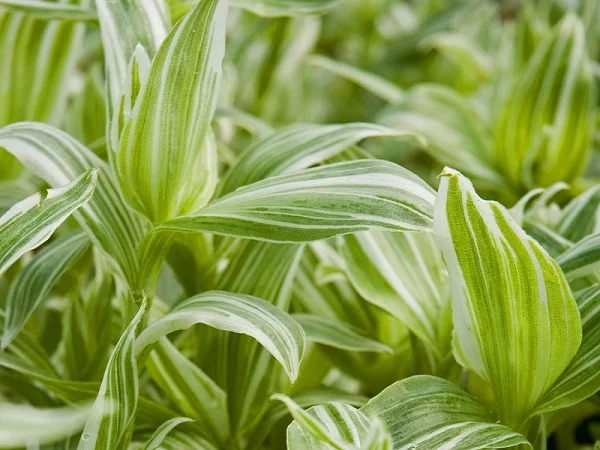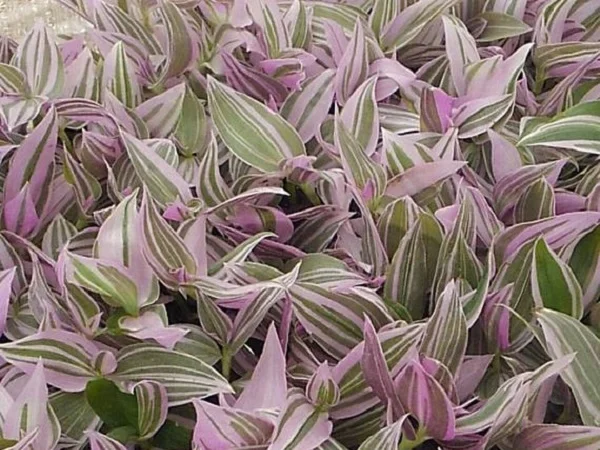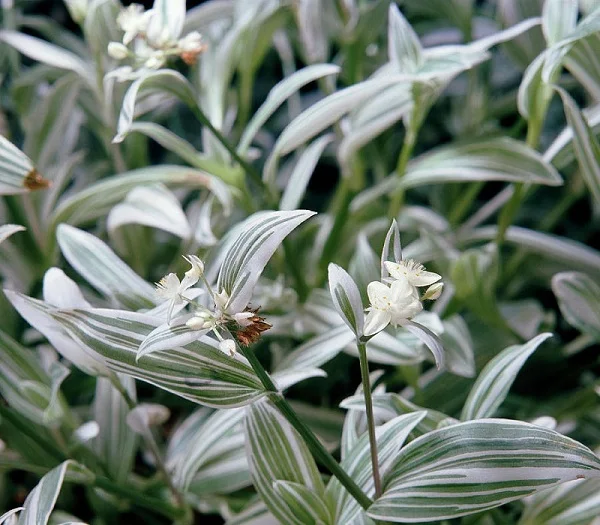Small-leaf Spiderwort (Tradescantia fluminensis) Care Indoors, Propagation, Problems & Remedies
Some links in this post may be affiliate links
Small-leaf Spiderwort (Tradescantia fluminensis) thrives in bright indirect light, average warmth, moderate humidity and consistently moist, rich, well-drained soil coupled with fortnightly feeding in the growing season.
If you love plants that grow fast and are easy to propagate, Tradescantia fluminensis is a winner. In this guide, we cover everything you need to know about keeping your Small-Leaf Spiderwort happy and thriving indoors.
Tradescantia fluminensis also called Wandering Trad, Inch Plant, River Spiderwort or Wandering Willie is one of the popular Tradescantia varieties which easily adapts to indoor growing conditions.
The leaves, about 2-4 inches long, tightly clasp the creeping or trailing stems of the Wandering Trad. The undersides of leaves are pale purple (mauve) and it produces pale purple sap.
Tradescantia fluminensis and Tradescantia chrysophylla (Baby Bunny Bellies Plant) are perfect for a hanging basket, pedestal, table-top, desktop or shelf where the stems can beautifully cascade downwards.

Botanical name: Tradescantia fluminensis
Synonmy name: Tradescantia albiflora
Family: Commelinaceae
Common names: Small-leaf Spiderwort, Wandering Trad, Inch Plant, River Spiderwort, Wandering Willie
Origin
Tradescantia fluminensis houseplant is native to the New World from southern Canada to northern Argentina, including West Indies where it occurs individually or in clumps in wooded areas or open fields.
Flower
Small-leaf Spiderwort flowers are white with three petals. It may occasionally flower indoors but the blooms are generally insignificant.
Varieties
Tradescantia fluminensis has many varieties like variegata with cream striped leaves, Quicksilver with white striped leaves and tricolor whose leaves are striped with cream and purple, among others.
Is Small-leaf Spiderwort poisonous?
Yes. Small-leaf Spiderwort is mildly toxic to humans, cats and dogs as indicated by Leaf and Paw. If ingested, the plant sap can cause burning in the mouth, tongue and throat. The sap may also cause skin irritation in sensitive skin; always wear gloves when handling the plant
Invasiveness as a weed
Small-leaf Spiderworts are fast-growing plants which are invasive and noxious weeds in many places. They successfully grow anywhere and will smoother ground level plants and prevent the natural regeneration of taller species.
Avoid planting River Spiderworts in the ground and dispose only after complete destruction as even an inch of these plants will sprout if not completely destroyed.
Where to Buy
Are you looking to add Small-leaf Spiderwort varieties to your collection? You may obtain them online from Amazon (Link to Amazon) or from Etsy (Link to Etsy).
How do you care for Small-leaf Spiderwort indoors?
To care for Small-leaf Spiderwort indoors, give it bright indirect light, average warmth of 16-270C, moderate humidity of 50-55% and consistently moist, fertile, well-drained soil coupled with fortnightly feeding during the growing season.
Tradescantia fluminensis care requires pruning to keep it neat, to reduce pest and disease infestations, to control growth and to rejuvenate growth. Repotting is necessary when it becomes extremely pot-bound. Keep reading for more on these growing conditions and how to achieve them.

Light Requirements
How much light does Small-leaf Spiderwort need?
Small-leaf Spiderwort grows best in bright indirect light. Place near a large, brightly-lit window. Keep it away from direct sunshine as it can lead to scorching of the leaves.
If the lighting is too low the plant may respond with leggy growth and yellow leaves. Therefore, use a grow light if the natural lighting is not sufficient.
Regularly rotate the pot to ensure that the plant receives light on all sides for even growth and prevent leggy growth.
Watering
How often should I water Small-leaf Spiderwort?
Water your Small-leaf Spiderwort thoroughly in spring and summer while allowing the top 1-2 inches of soil to dry out between waterings. Maintain the soil moist and avoid overwatering to prevent yellowing, rotting and leaf drop.
Cut down on watering in fall and winter to keep the soil slightly moist as growth is minimal at this time. Do not allow the soil to dry out completely to avoid wilting, drooping and leaf drop.
Use water that is at room temperature to avoid shocking the roots which can result in reduced growth and leaf drop. Use chlorine-free water like rain water or filtered water to prevent brown leaf tips.
Ensure that the pot has a drainage hole and the soil is well-draining to prevent waterlogging which can lead to root-rot and yellow leaves.
Temperature and Humidity
Small-leaf Spiderwort blossoms in an average temperature of 16-270C; a room temperature that is comfortable for you is ideal for this plant. Keep it away from drafts emanating from windy doors, drafty windows, heaters, AC vents as they cause temperature flactuations which lead in reduced growth, yellowing and leaf drop.
Tradescantia fluminensis has no need for high humidity; average humidity of 50-55% is ideal for this plant. However, where the humidity is too low, the plant will respond with dry, brown leaf tips. Therefore, to increase humidity, set the pot on a wet pebble tray or use a humidifier. Maintain proper air circulation to reduce fungal diseases.
Fertilizer
Feed Tradescantia fluminensis with a balanced, liquid fertilizer every 2 weeks during the growing period to promote a lush growth.
Withhold feeding in the cold season as the growth is minimal and feeding at this time may lead to fertilizer burn which is indicated by yellow leaves followed by plant death.
Every 1-2 months, flush out accumulated salts by running a stream of water through the soil until it comes out through the drainage holes.
Potting Mix
Small-leaf Spiderwort soil should be a rich, loose, well-draining potting mix to prevent it from getting soggy while providing the required nutrients.
Repotting
Repot your Small-leaf Spiderwort in the beginning of the growing season (spring to early summer), only when the plant has become extremely pot-bound; it grows best when root-bound.
Use a pot one size larger than the current one and free-draining soil that is rich in organic matter. Make sure that the pot has a drainage hole to prevent the soil from getting soggy as it can lead to root-rot and yellowing leaves.
Tradescantia fluminensis is magnificent in a hanging basket where the the stems can cascade downwards beautifully. Take a look at these hanging planters with macrame plant hangers on Amazon.
Pruning & Grooming
Pruning Small-leaf Spiderwort involves:
- Regular removal of dead foliage to maintain the plant neat as well as discourage pest and disease infestations.
- Pinching off the growing tips to control the growth and make it more bushy.
- Cutting back leggy stems at the beginning of the growing season to rejuvenate growth.
Occasionally clean the leaves by damp-wiping with a soft cloth to keep them clean as well as discourage pest and disease infestations.
Tradescantia fluminensis Propagation
Tradescantia fluminensis (Small-leaf Spiderwort) propagation can be done during the growing period by plants divison or from stem-cuttings.
Tradescantia fluminensis propagation by plant division
- Water the plant thoroughly at least 1 day before to make it easier to divide and also hasten establishment.
- Take the plant out of its pot and carefully divide it into sections. Ensure each sections has adequate roots and at least one set of leaves.
- Select a 6 or 8 inches pot and ensure that the pot has a drainage hole to prevent the soil from getting soggy as it can lead to rotting.
- Fill the pot with loose, free-draining soil and make a hole in the center of the pot. Ensure that the hole is slightly wider than the root base of the section.
- Place the section in the previously made hole and lightly firm the soil around the base while taking care not to bury it too deep; maintain the section at the same soil level it was in the previous pot.
- Water the soil thoroughly and place the set up in a well-lit, warm place until the new plant is well established after which you can begin routine care.
Tradescantia fluminensis propagation from stem cuttings in soil
The stem cuttings root easily so there is no need for rooting hormone.
- Take a stem cutting from a healthy plant of about 4-6 inches and ensure it bears at least two sets of leaves.
- Allow some time for the formation of a protective callus tissue over the cuts of the cuttings to prevent rotting.
- Fill a rooting container with loose, free-draining soil to a depth of about 4 inches. Lightly moisten the soil.
- With a pencil or similar object make a hole that is wider than the diameter of the cutting.
- Carefully insert the cutting in the hole made previously to a depth of about 3 inches.
- Place the set up in a warm, well-lit place and maintain the soil moist through out until new growth emerges.
- Allow the new plant to be well established before transplanting to individual pots after which you can begin routine care.

Small-leaf Spiderwort Problems & Solutions
Small-leaf Spiderwort problems are yellow leaves, brown leaf tips, plant dying, wilting leaves, leggy growth, loss of leaf color, pests and diseases among others. Read on for more on these problems, their remedies and solutions.
Yellow leaves
Why are the leaves on my Small-leaf Spiderwort turning yellow?
Some of the causes of yellow leaves on your Small-leaf Spiderwort are too little light, inconsistent watering, soggy soil, temperature stress, low humidity, and nutrients deficiency.
How to fix it
Too little light: Move the plant in a brighter spot or instal a grow light if the natural lighting is not enough.
Inconsistent watering: Do not water on a schedule. Water when the top 2-3 inches dry out. Never allow the soil to dry out completely.
Soggy soil: Use a pot with a drainage hole and well-draining soil.
Temperature stress: Keep the plant away from drafts coming from AC units, drafty windows, heat sources, windy doors and others.
Low humidity: Use a wet pebble tray or a humidifier to elevate humidity.
Nutrients deficiency: Feed the plant with a balanced, water-soluble fertilizer every 3-4 weeks in spring and summer.
Brown leaf tips
Why are the tips of my Small-leaf Spiderwort leaves turning brown?
The tips of your Small-leaf Spiderwort leaves are turning brown due to low humidity, salts buildup, and use of hard water.
How to fix it
Low humidity: To increase humidity, set the pot on a wet pebble tray, use a humidifier or grow the plant in a well-lit bathroom, kitchen, laundry area and other moist areas in the home.
Salts buildup: Regularly flush out accumulated salts from the soil by running a stream of water through the soil until it drains through the drainage hole.
Use of hard water: Use chlorine-free water like rain water or filtered water.
Plant dying
Why is my Small-leaf Spiderwort plant dying?
Your Small-leaf Spiderwort plant is dying due to root-rot disease which is prevalent in soggy soil. It is characterized by yellowing and wilting leaves, rapidly followed by browning and plant collapse.
How do you revive Small-leaf Spiderwort?
- Carefully slip the plant out of its pot and inspect the roots.
- Trim the brown-black, mushy roots and treat the healthy roots with a copper-based fungicidal solution as recommended by the manufacturer.
- Disinfect the pot with the fungicidal solution or use a fresh pot to repot the plant in fresh, well-draining soil.
- Do not water the plant immediately and keep it dry for 5-7 days before you can resume watering.
- Use a pot with a drainage hole and well-draining soil to prevent the soil from getting soggy.
- Lessen watering in fall and winter as growth is slowed at this time; keep the soil slightly moist.
Wilting leaves
Why is my Small-leaf Spiderwort wilting?
Your Small-leaf Spiderwort is wilting due to underwatering, drafts, and pests infestation.
How to fix it
Underwatering: Water when the top 2-3 inches of soil dry out but never allow the soil to dry out completely.
Drafts: Keep the plant away from drafts emanating from hot air vents, AC units, hot stoves, windy doors among others.
Pest infestations: Regularly inspect the plant for these pests and take timely control measures.
Leggy growth
Leggy growth on Small-leaf Spiderwort is caused by too little light, overwatering, and excessive feeding.
How to fix it
Too little light: Position the plant in a brighter spot or instal a grow light if the natural lighting is not adequate.
Overwatering: Water when the top 2-3 inches of soil dry but do not allow the soil to dry out completely.
Excessive feeding: Feed the plant with a balanced, liquid fertilizer once a month in spring and summer. Do not feed in fall and winter.
Loss of leaf color
Loss of leaf color on Small-leaf Spiderwort is caused by too little light. Move the plant to a brighter spot, as it grows best in bright indirect light or instal a grow light if you do not have adequate light in your home.
Pests
Common pests on Small-leaf Spiderwort are scales, mealybugs and aphids which are prevent in dry conditions.
How to fix it
- Isolate the affected plant to prevent spread to other plants.
- Treat the infested plant with neem oil or insecticidal soap as per the manufacturers' recommendations.
- Regularly check between and underneath the leaves for these pests and carry out timely control measures.
- Keep the plant properly pruned and upscale humidity to discourage pest infestations.
Diseases
Small-leaf Spiderwort is prone to leaf spot which presents as brown leaf patches surrounded by a yellow halo.
How to fix it
- Remove and burn the affected parts to reduce spread to the rest of the plants.
- Spray the affected plant with a systemic fungicide and ensure to cover all the parts with the fungicidal solution.
- Keep the plant on the dry side, do not mist it and ensure good air flow.
- Use a pot with a drainage hole and well-draining soil.
Conclusion
Small-Leaf Spiderwort (Tradescantia fluminensis) is a fast-growing, easy-care plant that will bring a lush, tropical feel to any space. Whether you are looking for a hanging plant, a shelf centerpiece, or a quick-growing greenery fix, this plant delivers.
With minimal effort, you will have cascading vines of glossy, vibrant leaves filling your home with beauty. Just give it bright indirect light, moderate watering, average warmth, regular fertilizer, and occasional pruning, and you will be rewarded with a thriving, low-maintenance houseplant.
Frequently Asked Questions
1. Can I grow Small-Leaf Spiderwort in low light?
Yes, but it will grow slower and may become leggy. Bright indirect light is best for Small-Leaf Spiderwort.
2. Is Small-Leaf Spiderwort pet-friendly?
No. Small-Leaf Spiderwort is toxic to pets if ingested. Keep it out of reach of cats and dogs.
3. Why are my Tradescantia leaves losing color?
It is likely that your plant is not getting enough light. Move it closer to a window or supplement with grow lights.
4. How often should I prune my Small-Leaf Spiderwort?
Prune your Small-Leaf Spiderwort regularly to encourage a bushy growth and prevent legginess.
5. Can I keep Small-Leaf Spiderwort in a hanging basket?
Yes. Small-Leaf Spiderwort looks stunning in hanging planters where its vines can trail beautifully.
You liked it? Share on social media.
Related Content
Amazon Associates Disclosure
Homeplantsguide.com is a participant in the Amazon Services LLC Associates Program, an affiliate advertising program designed to provide a means for sites to earn advertising fees by advertising and linking to amazon.com.





